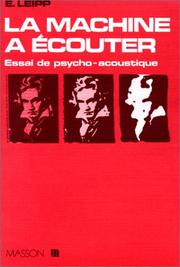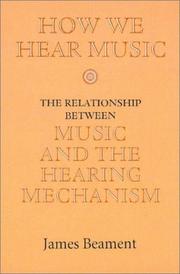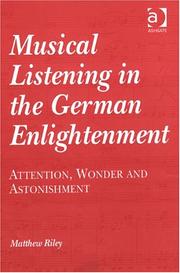| Listing 1 - 10 of 10 |
Sort by
|
Book
ISBN: 3777602507 Year: 1974 Publisher: Stuttgart Hirzel
Abstract | Keywords | Export | Availability | Bookmark
 Loading...
Loading...Choose an application
- Reference Manager
- EndNote
- RefWorks (Direct export to RefWorks)

ISBN: 2225458375 9782225458378 Year: 1977 Publisher: Paris: Masson,
Abstract | Keywords | Export | Availability | Bookmark
 Loading...
Loading...Choose an application
- Reference Manager
- EndNote
- RefWorks (Direct export to RefWorks)
Auditory perception. --- Hearing --- Sound --- Perception auditive --- Audition (Physiologie) --- Son --- Experiments --- Psychological aspects --- Expériences --- Aspect psychologique --- Auditory perception --- Testing --- -Hearing --- -Acoustics --- Audition (Physiology) --- Physiological acoustics --- Bioacoustics --- Senses and sensation --- Audiology --- Auditory pathways --- Deafness --- Ear --- Listening --- Sound perception --- Perception --- Word deafness --- -Experiments --- Expériences --- Acoustics --- Audiometer --- 78.82 --- Hearing - Experiments --- Hearing - Testing --- Music --- akoestiek --- muziektheorie
Book
ISBN: 0486607534 Year: 1954 Publisher: New York Dover
Abstract | Keywords | Export | Availability | Bookmark
 Loading...
Loading...Choose an application
- Reference Manager
- EndNote
- RefWorks (Direct export to RefWorks)
Vibrations --- Music --- Musique --- Acoustics and physics --- Physiological aspects --- Acoustique et physique --- Aspect physiologique --- 7.01 --- 78.01 --- Muziek ; theorie ; fysiologische en psychologische aspecten --- Trefwoord --- Geluid ; geluiden ; klanken --- Akoestiek --- Kunst ; theorie, filosofie, esthetica --- Muziek ; theorie, filosofie, esthetica --- 78.86.1 --- Acoustique --- Sound --- Électroacoustique. --- Electro-acoustics --- Ouïe. --- Hearing --- Sound. --- Hearing. --- Ouïe --- Électroacoustique. --- Ouïe

ISBN: 0851159400 0851158137 9786611949037 1281949035 1846154413 9780851159409 Year: 2005 Publisher: Woodbridge: Boydell press,
Abstract | Keywords | Export | Availability | Bookmark
 Loading...
Loading...Choose an application
- Reference Manager
- EndNote
- RefWorks (Direct export to RefWorks)
Choice Outstanding Academic Title (2002)Our hearing system chose the sounds for music. During the past fifty years there have been spectacular advances in our knowledge of how that system works and it seems possible that it might provide explanations for a range of musical phenomena. This book begins by discussing the early evolution of simple 'western' tonal music; what exactly were the characteristics of the intervals and scales which hearing selected. It then considers problems such as what hearing has selected as instrumental tone, and why we have such a peculiar assessment of loudness; why is that independent of pitch, and why is hearing so sensitive to time? Does the mechanism of hearing determine our pitch discrimination, which differs so much across our hearing range? Amongst other things, this discussion leads to the conclusion that the harmonics of musical sounds, which are the basis of so much theory about music, did not and cannot play the role which has been so widely attributed to them ever since the work of Helmholtz in 1870. There follows a simplified account of the hearing mechanism: how musical sound is coded by the ear, the nature of the processing stations through which the information passes before it creates sensation in the cortex, and the extent to which it provides answers to the questions which have been raised. This produces a rather different view of the basis of some fundamental features of music from those which are commonly held. It also leads to the conclusion that music started with primitive instruments rather than with the human voice. Finally, the biological reasons for the hearing mechanism behaving as it does are explained, and thus the reasons for the sensations of music being experienced in the way they are. No scientific knowledge is assumed; any simple physical acoustics required is explained, and there are no mathematical equations. The late Professor Sir JAMES BEAMENT was a distinguished scientist and musician, who taught and examined music students at Cambridge University.
Acoustics --- Acoustique --- Akoestiek --- Audition (Physiology) --- Gehoor --- Hearing --- Music -- Perception --- Musical perception --- Musique -- Perception --- Muziek -- Perceptie --- Muzikale perceptie --- Muzikale waarneming --- Oreille absolue --- Oreille musicale --- Ouïe --- Perception de la musique --- Perception musicale --- Physiological acoustics --- Music --- Acoustics and physics --- Music - Acoustics and physics. --- Music - Acoustics and physics --- Music - Physiological aspects --- Musical perception. --- Hearing. --- Acoustics and physics. --- Ouïe --- Musique --- Acoustique et physique --- 515 --- 840 --- Musical acoustics --- Physics --- Sound --- Monochord --- Auditory perception --- Bioacoustics --- Senses and sensation --- Audiology --- Auditory pathways --- Deafness --- Ear --- Listening --- Akoestika --- Muziekgeschiedenis: essays (histor. onderwerpen, literaire analyses) --- Psychological aspects --- 78.82 --- Acoustics. --- Hearing Mechanism. --- Music. --- Sound Direction. --- Western Music.
Book
ISBN: 9782212138726 2212138725 Year: 2015 Publisher: Paris: Eyrolles,
Abstract | Keywords | Export | Availability | Bookmark
 Loading...
Loading...Choose an application
- Reference Manager
- EndNote
- RefWorks (Direct export to RefWorks)
Point d'entrée de cet ouvrage, les 420 exemples sonores fournis sur le DVD-Rom placent le lecteur dans une situation d'écoute attentive, à partir de laquelle il va découvrir au fil des chapitres comment analyser la structure acoustique des sons et évaluer leurs qualités musicales. L'analyse s'appuie sur l'usage du sonagramme, représentation visuelle qui révèle la structure spectrale et temporelle des sons, et se lit à la manière d'une partition musicale, sans nécessiter de connaissances avancées en acoustique. Mais l'analyse spectrotemporelle ne suffit pas pour rendre compte des qualités d'un son dont l'écoute diffère d'une personne à l'autre. L'auteur fournit ainsi une synthèse des données récentes sur le système auditif, la reconnaissance des formes et la catégorisation cognitive qui permettent ensuite d'aborder l'étude des qualités musicales des sons - intensité, hauteur, timbre -, les problèmes posés par l'accordage des sons instrumentaux et la grande diversité des écoutes de la voix humaine. Contenu du DVD-Rom d'accompagnement Des "livrets-sons" au format ePub 3 (un par chapitre) pour écouter les sons sur son Smartphone ou sa tablette. Le livre complet au format PDF avec les 420 sons aux formats MP3 et WAV.
Music --- Musical analysis --- Musique --- Analyse musicale --- Acoustics and physics --- Acoustique et physique --- Ecoute musicale (pratique) --- Acoustique --- Hearing --- Écoute musicale (pratique) --- Acoustique. --- Écoute musicale (pratique) --- Muziektheorie --- Akoestiek --- 20e eeuw
Book
ISSN: 12594482 ISBN: 9782745326409 2745326406 Year: 2014 Volume: 172 Publisher: Paris: Champion,
Abstract | Keywords | Export | Availability | Bookmark
 Loading...
Loading...Choose an application
- Reference Manager
- EndNote
- RefWorks (Direct export to RefWorks)
Le père jésuite Louis-Bertrand Castel (1688-1757) a connu son heure de gloire au XVIIIe siècle grâce à son fameux clavecin oculaire. Partant de l'idée qu'il existe une analogie physique entre le son et la couleur, Castel imagine un clavecin qui dispenserait une musique de couleurs - des couleurs préalablement organisées en gamme sur la base de leurs correspondances naturelles avec les sons. Par là, Castel cherche à mettre au jour les principes rationnels qui déterminent l'ordre de la nature et à fonder l'art en raison. Dès lors, l'art en vient à témoigner d'une intelligence divine compatible avec la raison et la musique des couleurs, en ce qu'elle rend ces principes fondateurs plus visibles que tout autre art, s'apparente à une forme de révélation. La musique colorée permet en outre de sauver l'homme de l'ennui, cette langueur qui lui ôte le sentiment d'exister, en assurant la pérennité du mouvement et de la surprise, en renouvelant le plaisir de la variété, en satisfaisant l'inconstance naturelle qui le pousse sans relâche vers d'autres objets de plaisir. De là à promouvoir un art libertin, il n'y a qu'un pas, que Castel franchit à son insu. Cette tendance est d'autant plus troublante que l'ennui, chez Castel, se trouve privé de dimension métaphysique et qu'il autorise de ce fait la recherche de la jouissance, au travers de l'expérience esthétique. Le divertissement a gagné ses lettres de noblesse dans le monde.
Music --- anno 1700-1799 --- 78.43.1 --- 78.25 --- 78.81 --- Music and color --- Color-hearing --- Synesthesia --- Harpsichord --- Music and science --- History --- Castel, Louis-Bertrand, --- Harpsichord - History - 18th century --- Music and science - History - 18th century --- Harpsichord - France - History - 18th century --- Castel, Louis-Bertrand, - 1688-1757

ISBN: 0945193203 Year: 1991 Publisher: New York (N.Y.) : Pendragon press,
Abstract | Keywords | Export | Availability | Bookmark
 Loading...
Loading...Choose an application
- Reference Manager
- EndNote
- RefWorks (Direct export to RefWorks)
Auditory perception --- Music --- -Music --- -Art music --- Art music, Western --- Classical music --- Musical compositions --- Musical works --- Serious music --- Western art music --- Western music (Western countries) --- Sound perception --- Hearing --- Perception --- Word deafness --- Physiological aspects --- Psychological aspects --- Auditory perception. --- Physiological aspects. --- Psychological aspects. --- -Physiological aspects --- -Sound perception --- Art music --- Music psychology --- Music physiology --- Physiological aspects of music --- Psychology --- 78.83
Book
ISBN: 0190271116 0190271140 0190271124 9780190271114 Year: 2017 Publisher: New York, NY: Oxford University Press,
Abstract | Keywords | Export | Availability | Bookmark
 Loading...
Loading...Choose an application
- Reference Manager
- EndNote
- RefWorks (Direct export to RefWorks)
From prehistoric bone flutes to pipe organs to digital synthesizers, instruments have been important to musical cultures around the world. Yet, how do instruments affect musical organization? And how might they influence players' bodies and minds? Music at Hand explores these questions with a distinctive blend of music theory, psychology, and philosophy. Practicing an instrument, of course, builds bodily habits and skills. But it also develops connections between auditory and motor regions in a player's brain. These multi-sensory links are grounded in particular instrumental interfaces. They reflect the ways that an instrument converts action into sound, and the ways that it coordinates physical and tonal space. Ultimately, these connections can shape listening, improvisation, or composition. This means that pianos, guitars, horns, and bells are not simply tools for making notes. Such technologies, as creative prostheses, also open up possibilities for musical action, perception, and cognition. Throughout the book, author Jonathan De Souza examines diverse musical case studies-from Beethoven to blues harmonica, from Bach to electronic music-introducing novel methods for the analysis of body-instrument interaction. A companion website supports these analytical discussions with audiovisual examples, including motion-capture videos and performances by the author. Written in lucid prose, Music at Hand offers substantive insights for music scholars, while remaining accessible to non-specialist readers. This wide-ranging book will engage music theorists and historians, ethnomusicologists, organologists, composers, and performers-but also psychologists, philosophers, media theorists, and anyone who is curious about how musical experience is embodied and conditioned by technology.
Music --- Psychomotor Performance --- Acoustic Stimulation --- Auditory Perception --- Auditory Processing --- Perception, Auditory --- Processing, Auditory --- Auditory Perceptual Disorders --- Hearing --- Auditory Stimulation --- Stimulation, Acoustic --- Stimulation, Auditory --- Music Therapy --- Noise --- Sound --- Music psychology --- Art music --- Art music, Western --- Classical music --- Musical compositions --- Musical works --- Serious music --- Western art music --- Western music (Western countries) --- Performance&delete& --- Psychological aspects --- psychology --- physiology --- Psychology --- Performance --- Psychological aspects. --- 78.82 --- Muziek --- Psychologische aspecten
Book
ISBN: 9782930368474 2930368470 Year: 2011 Publisher: Hornu MAC's
Abstract | Keywords | Export | Availability | Bookmark
 Loading...
Loading...Choose an application
- Reference Manager
- EndNote
- RefWorks (Direct export to RefWorks)
Don de l'auteur
Art and music --- Music in art --- Art et musique --- Musique dans l'art --- Exhibitions. --- Expositions --- Oosterlynck, B. --- Muziek in de kunst --- kunst en muziek --- Oosterlynck Baudouin --- 7.071 OOSTERLYNCK --- kunst --- België --- twintigste eeuw --- eenentwintigste eeuw --- muziek --- Exhibitions --- Oosterlynck, Boudouin --- Installations (Art) --- Contemporary art --- Belgium --- 78.49 --- Composers --- Composers. --- Installations (Art). --- Soundscapes (Music). --- Oosterlynck, Baudouin, --- Belgium. --- Art --- hearing [sense] --- sight [sense] --- sound art --- Performative Art --- Oosterlynck, Baudouin

ISBN: 0754632679 9780754632672 Year: 2004 Publisher: Aldershot: Ashgate,
Abstract | Keywords | Export | Availability | Bookmark
 Loading...
Loading...Choose an application
- Reference Manager
- EndNote
- RefWorks (Direct export to RefWorks)
Music --- Listening --- Philosophy and aesthetics --- History --- History and criticism --- 523 --- Muziekgeschiedenis (Klassiek) --- Listening. --- Musique --- Ecoute (Psychologie) --- History and criticism. --- Philosophie et esthétique --- Histoire --- Histoire et critique --- Philosophie et esthétique --- Music appreciation --- Auditory selective attention --- Attention auditive sélective --- Appréciation --- Art music --- Art music, Western --- Classical music --- Musical compositions --- Musical works --- Serious music --- Western art music --- Western music (Western countries) --- Auding --- Attention --- Comprehension --- Educational psychology --- Hearing --- 78.81 --- 78.82 --- 78.25 --- Music - Philosophy and aesthetics - History - 18th century --- Music - Germany - 18th century - History and criticism
| Listing 1 - 10 of 10 |
Sort by
|

 Search
Search Feedback
Feedback About UniCat
About UniCat  Help
Help News
News